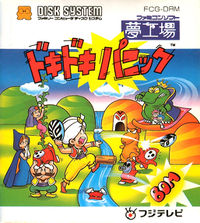| Site Notice |
|---|
|
We have a limited coverage policy. Please check our coverage page to see which articles are allowed. |
Difference between revisions of "Yume Kōjō: Doki Doki Panic"
m |
m |
||
| (2 intermediate revisions by the same user not shown) | |||
| Line 10: | Line 10: | ||
|category=2D platformer | |category=2D platformer | ||
|players=1 | |players=1 | ||
| + | |ownershiprights=©1987 NINTENDO / FUJI TV | ||
|no_pricing=true | |no_pricing=true | ||
|releasejp=July 10, 1987 | |releasejp=July 10, 1987 | ||
|no_ratings=true | |no_ratings=true | ||
}} | }} | ||
| − | '''''Yume Kōjō: Doki Doki Panic''''' is a 2D platforming game released in July 1987 for the [[Family Computer Disk System|Famicom Disk System]]. | + | '''''Yume Kōjō: Doki Doki Panic''''' is a 2D platforming game released in July 1987 for the [[Family Computer Disk System|Famicom Disk System]]. Originally starting as a prototype for a vertically-scrolling platformer with elements such as two-player co-operative play and the ability to pick up and throw other players and objects, Nintendo developed the game as part of a collaboration with {{wp|Fuji TV|Fuji Television}} to promote their "Yume Kōjō '87" event, a large-scale festival primarily meant to showcase Fuji's latest shows and products, using the mascot characters created for the event as the game's playable cast. |
Outside Japan, the game was notably altered and released as the [[Nintendo Entertainment System|NES]] title ''[[Super Mario Bros. 2]]'', as [[Nintendo of America]] saw the original ''[[Super Mario Bros.: The Lost Levels|Super Mario Bros. 2]]'' as too difficult for western players, and too similar to the first game to sell well. | Outside Japan, the game was notably altered and released as the [[Nintendo Entertainment System|NES]] title ''[[Super Mario Bros. 2]]'', as [[Nintendo of America]] saw the original ''[[Super Mario Bros.: The Lost Levels|Super Mario Bros. 2]]'' as too difficult for western players, and too similar to the first game to sell well. | ||
| Line 37: | Line 38: | ||
==External links== | ==External links== | ||
| + | {{otherwikis|italics=yes|Super Mario Wiki=1|StrategyWiki=Doki Doki Panic}} | ||
*{{wp|Super Mario Bros. 2|''Super Mario Bros. 2'' on Wikipedia}} | *{{wp|Super Mario Bros. 2|''Super Mario Bros. 2'' on Wikipedia}} | ||
| − | |||
| − | |||
[[Category:Famicom Disk System games]] | [[Category:Famicom Disk System games]] | ||
[[Category:1987 games]] | [[Category:1987 games]] | ||
[[Category:Games developed by Nintendo EAD]] | [[Category:Games developed by Nintendo EAD]] | ||
Latest revision as of 02:06, 18 June 2021
| Yume Kōjō: Doki Doki Panic | ||||||||||||||
| 夢工場 ドキドキパニック Yume Kōjō: Doki Doki Panikku | ||||||||||||||
| ||||||||||||||
| ||||||||||||||
| ||||||||||||||
|
Yume Kōjō: Doki Doki Panic is a 2D platforming game released in July 1987 for the Famicom Disk System. Originally starting as a prototype for a vertically-scrolling platformer with elements such as two-player co-operative play and the ability to pick up and throw other players and objects, Nintendo developed the game as part of a collaboration with Fuji Television to promote their "Yume Kōjō '87" event, a large-scale festival primarily meant to showcase Fuji's latest shows and products, using the mascot characters created for the event as the game's playable cast.
Outside Japan, the game was notably altered and released as the NES title Super Mario Bros. 2, as Nintendo of America saw the original Super Mario Bros. 2 as too difficult for western players, and too similar to the first game to sell well.
Story
The game is set in a storybook which tells the story of the land of Mu, where the weather is determined by the quality of dreams and the citizens have built a dream machine to have consistently good dreams. One day, the evil frog Mamu invades the land and converts the machine into a nightmare machine. However, the citizens learn of Mamu's weakness to vegetables and use this to defeat him.
An Arabian family currently owns the book. The pet monkey Rusa gives the book to young twins Poki and Piki, but they fight over it and end up ripping out the last page, erasing the ending of the story and freeing Mamu. He reaches out of the book and kidnaps the twins, grabbing them and pulling them inside. Rusa tells the rest of the family about this, and they enter the book themselves to save the two twins.
Gameplay
Yume Kōjō: Doki Doki Panic is a platformer with both side-scrolling and vertically scrolling elements. The game stars the Yume Kōjō '87 mascots, an Arabian-themed family consisting of four members: the twins Imajin and Lina, and their parents Papa and Mama. The player can play as each of these four characters, and each of them have their own unique stats and abilities. Rather than by jumping on enemies, the player instead attacks by picking up objects or enemies (either by standing on them or pulling them out of the ground) and throwing them.
The player has a health bar consisting of two segments, which can be expanded by collecting a large heart; these can be found by using a magic lamp, which spawns a door leading to a parallel world. Also within each stage are cherries, which give the player a star that makes them invincible when five of them are collected.
After each stage, if the player has collected any coins (obtained by pulling up plants in the parallel world), they can play a slot machine minigame to potentially earn extra lives. The player's progress can also be saved between stages. After clearing a world, the player can choose to play as a different character or replay a world, but each character's progress is saved differently; the player must clear the game with all four characters to view the true ending.
Technical details
|
External links
Yume Kōjō: Doki Doki Panic on other NIWA Wikis: | ||||
|---|---|---|---|---|
|
